Florida is a birder's paradise,
thanks to its diversity of habitats, its
location on migration routes, the extent
of its remaining wild lands, and its
geographic span of both temperate and
subtropical climates. More than 500
species have been documented in the
state, including such sought-after birds
as the rare Florida burrowing owl, the
Florida scrub-jay, the snail kite and
Florida's wealth of wading birds.
Below is a list of the more common
birds known to live in, or visit, the
area around the Ranch in Cocoa.
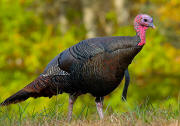 |
| Wild Turkey |
The Phasianidae is a family of birds which
consists of the pheasants and their allies. These
are terrestrial species, variable in size but
generally plump, with broad relatively short wings.
Many species are gamebirds, or have been
domesticated as a food source for humans. There are
180 species world wide, 16 North American species,
and one Florida species.
New World quail
Order:
Galliformes Family:
Odontophoridae
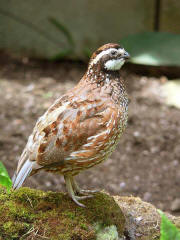 |
| Northern Bobwhite |
The New World quails are small, plump terrestrial
birds only distantly related to the quails of the
Old World, but named for their similar appearance
and habits. There are 32 species, world-wide, all
found only in the Americas, six North American
species, and one Florida species.
Loons
Order:
Gaviiformes Family:
Gaviidae
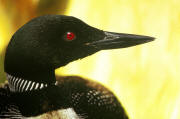 |
| Common Loon |
Loons are aquatic birds size of a large duck, to
which they are unrelated. Their plumage is largely
grey or black, they have spear-shaped bills. Loons
swim well, and fly adequately, but, because their
legs are placed towards the rear of the body, are
almost hopeless on land. There are five species
world-wide, five North American species, and three
Florida species. We have only seen the Common Loon
here.
Herons and
Egrets
Order:
Ciconiiformes Family:
Ardeidae
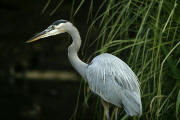 |
| Great Blue Heron |
The family Ardeidae contains the herons, egrets,
and bitterns. Herons and Egrets are medium to large
sized wading birds with long necks and legs.
Bitterns tend to be shorter necked and more
secretive. Unlike other long necked birds such as
storks, ibises and spoonbills, members of Ardeidae
fly with their necks retracted. There are 61 species
world wide, 17 North American species, and 12
Florida species. Only 5 of these visit the Ranch.
Ibises and Spoonbills
Order:
Ciconiiformes Family:
Threskiornithidae
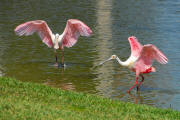 |
| Roseate Spoonbill |
The family Threskiornithidae includes the ibises
and spoonbills. They have long, broad wings. Their
bodies tends to be elongated, the neck more so, with
rather long legs. The bill is also long, decurved in
the case of the ibises, straight and distinctively
flattened in the spoonbills. There are 36 species
world wide, five North American species, and five
Florida species.
Storks
Order:
Ciconiiformes Family:
Ciconiidae
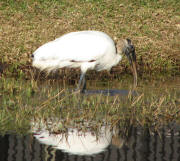 |
| Wood Stork |
Storks are large, heavy, long-legged, long-necked
wading birds with long stout bills and wide
wingspans. They lack the powder down that other
wading birds such as herons, spoonbills and ibises
use to clean off fish slime. Storks lack a pharynx
and are mute. There are 19 species world wide, two
North American species, and one Florida species.
New World vultures
Order:
Ciconiiformes Family:
Cathartidae
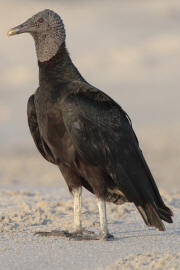 |
| Black Vulture |
The New World vultures are not closely related to
Old World vultures, but superficially resemble them
because of convergent evolution. Like the Old World
vultures, they are scavengers However, unlike Old
World vultures, which find carcasses by sight, New
World vultures have a good sense of smell with which
they located carcasses. There are seven species
world wide, all found only in the Americas, three
North American species and two Florida species.
Hawks, Kites and
Eagles
Order:
Falconiformes Family:
Accipitridae
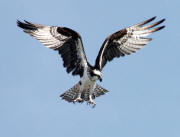 |
| Osprey |
The family Accipitridae is a family of birds of
prey and include hawks, eagles, kites, harriers and
Old World vultures. These birds have very large
powerful hooked beaks for tearing flesh from their
prey, strong legs, powerful talons, and keen
eyesight. There are 233 species world wide, 28 North
American species, and 19 Florida species.
Caracaras and Falcons
Order:
Falconiformes Family:
Falconidae
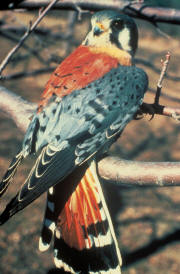 |
| American Kestrel |
Falconidae is a family of diurnal birds of prey,
notably the falcons and caracaras. They differ from
hawks, eagles, and kites in that they kill with
their beaks instead of their feet. There are 62
species world wide, ten North American species, and
five Florida species.
Gallinules
Order:
Gruiformes Family:
Rallidae
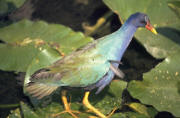 |
| Purple Gallinule |
Rallidae is a large family of small to
medium-sized birds which includes the rails, crakes,
coots, and gallinules. The most typical family
members occupy dense vegetation in damp environments
near lakes, swamps, or rivers. In general they are
shy and secretive birds, difficult to observe. Most
species have strong legs, and have long toes which
are well adapted to soft, uneven surfaces. They tend
to have short, rounded wings and be weak fliers.
There are 143 species world wide, 13 North American
species, and nine Florida species.
Cranes
Order:
Gruiformes Family:
Gruidae
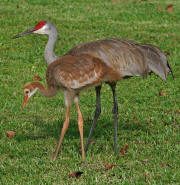 |
| Sandhill Crane |
Cranes are large, long-legged and long-necked
birds. Unlike the similar-looking but unrelated
herons, cranes fly with necks outstretched, not
pulled back. Most have elaborate and noisy courting
displays or "dances". There are 15 species
worldwide, three North American species, and two
Florida species.
Doves
Order:
Columbiformes Family:
Columbidae
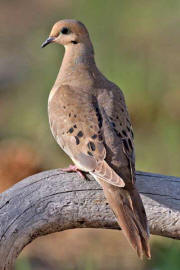 |
| Mourning Dove |
Pigeons and doves are stout-bodied birds with
short necks and short slender bills with a fleshy
cere. There are 308 species world wide, 18 North
American species, and 14 Florida species.
Barn owls
Order:
Strigiformes Family:
Tytonidae
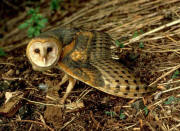 |
| Barn Owl |
Barn owls are medium to large sized owls with
large heads and characteristic heart-shaped faces.
They have long strong legs with powerful talons.
There are 16 species world wide, one North American
species, and one Florida species.
Typical owls
Order:
Strigiformes Family:
Strigidae
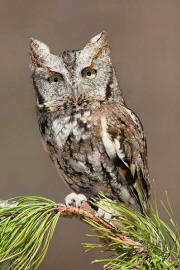 |
| Eastern Screech Owl |
Typical owls are small to large solitary
nocturnal birds of prey. They have large
forward-facing eyes and ears, a hawk-like beak, and
a conspicuous circle of feathers around each eye
called a facial disk. There are 195 species world
wide, 21 North American species, and nine Florida
species.
Nightjars
Order:
Caprimulgiformes Family:
Caprimulgidae
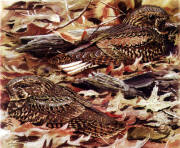 |
| Chuck-wills-widow |
Nightjars are medium-sized nocturnal birds with
long wings, short legs and very short bills that
usually nest on the ground. Most have small feet, of
little use for walking, and long pointed wings.
Their soft plumage is crypically coloured to
resemble bark or leaves. There are 86 species world
wide, nine North American species, and five Florida
species.
Swifts
Order:
Apodiformes Family:
Apodidae
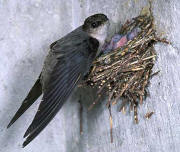 |
| Chimney Swift |
The swifts are small aerial birds, spending the
majority of their lives flying. These birds have
very short legs and never settle voluntarily on the
ground, perching instead only on vertical surfaces.
Many swifts have very lobg swept-back wings that
resemble a crescent or a boomerang. There are 98
species world wide, nine North American species, and
four Florida species.
Hummingbirds
Order:
Apodiformes Family:
Trochilidae
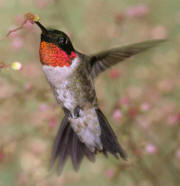 |
| Ruby Throated Hummingbird |
Hummingbirds are small birds capable of hovering
in mid-air due to the rapid flapping of their wings.
They are the only birds that can fly backwards.
There are 337 species world wide, 23 North American
species, and ten Florida species.
Kingfishers
Order:
Coraciiformes Family:
Alcedinidae
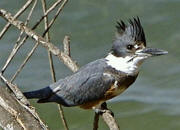 |
| Belted Kingfisher |
Kingfishers are medium sized birds with large
heads, long pointed bills, short legs, and stubby
tails. There are 94 species world wide, three North
American species, and one Florida species.
Woodpeckers and
Sapsuckers
Order:
Piciformes Family:
Picidae
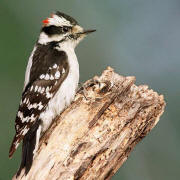 |
| Downy Woodpecker |
Woodpeckers are small to medium sized birds with
chisel like beaks, short legs, stiff tails and long
tongues used for capturing insects. Some species
have feet with two toes pointing forward, and two
backward, while several species have only three
toes. Many woodpeckers have the habit of tapping
noisily on tree trunks with their beaks. There are
218 species world wide, 26 North Amwerican species,
and ten Florida species.
Shrikes
Order:
Passeriformes Family:
Laniidae
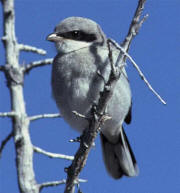 |
| Loggerhead Shrike |
Shrikes are passerine birds known for their habit
of catching other birds and small animals and
impaling the uneaten portions of their bodies on
thorns. A typical shrike's beak is hooked, like a
bird of prey. There are 31 species world wide, three
North American species, and one Florida species.
Jays and Crows
Order:
Passeriformes Family:
Corvidae
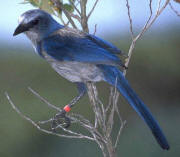 |
| Florida Scrub-Jay |
The Corvidae family includes crows, ravens, jays,
choughs, magpies, treepies, nutcrackers, and ground
jays. Corvids are above average in size for the bird
order Passeriformes. Some of the larger species show
levels of learned behavior of a high degree. There
are 120 species world wide, 21 North American
speicies, and four Florida species.
Swallows and Martins
Order:
Passeriformes Family:
Hirundinidae
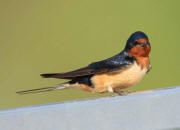 |
| Barn Swallow |
The Hirundinidae family is a group of passerines
characterised by their adaptation to aerial feeding.
Their adaptations include a slender streamlined
body, long pointed wings and short bills with wide
gape. The feet are designed for perching rather than
walking, and the front toes are partially joined at
the base. There are 75 species world wide, 14 North
American species, and ten Florida species.
Treecreepers
Order:
Passeriformes Family:
Certhiidae
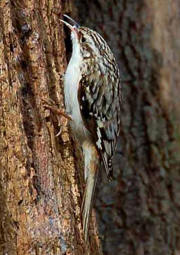 |
| Brown Creeper |
Treecreepers are small woodland birds, brown
above and white below. They have thin pointed
down-curved bills, which they use to extricate
insects from bark. They have stiff tail feathers,
like woodpeckers, which they use to support
themselves on vertical trees. There are six species
world wide, one North American species , and one
Florida species.
Wrens
Order:
Passeriformes Family:
Troglodytidae
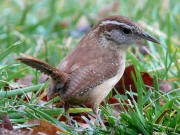 |
| Carolina Wren |
Wrens are small and inconspicuous birds, except
for their loud songs. They have short wings and a
thin down-turned bill. Several species often hold
their tails upright. All are insectivorous. There
are 79 species world wide, nine North American
species, and seven Florida species.
Thrushes
Order:
Passeriformes Family:
Turdidae
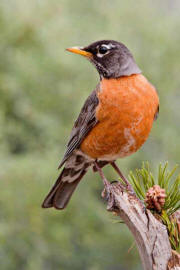 |
| American Robin |
The Thrushes are a group of passerine birds that
occur mainly but not exclusively in the Old World.
They are plump, soft plumaged, small to medium sized
insectivores or sometimes omnivores, often feeding
on the ground. Many have attractive songs. There are
335 species world wide, 28 North American species,
and ten Florida species.
Mimids
Order:
Passeriformes Family:
Mimidae
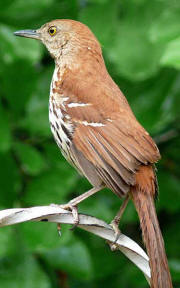 |
| Brown Thrasher |
The Mimids are a family of passerine birds that
includes thrashers, mockingbirds, tremblers, and the
New World catbirds. These birds are notable for
their vocalization, especially their remarkable
ability to mimic a wide variety of birds and other
sounds heard outdoors. The species tend towards dull
grays and browns in their appearance. There are 35
species world wide, 13 North American species, and
six Florida species.
Waxwings
Order:
Passeriformes Family:
Bombycillidae
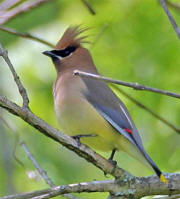 |
| Cedar Waxwing |
The waxwings are a group of passerine birds
characterised by soft silky plumage and unique red
tips to some of the wing feathers. In the Bohemian
and Cedar Waxwings, these tips look like sealing
wax, and give the group its name. These are arboreal
birds of northern forests. They live on insects in
summer and berries in winter. There are three
species world wide, two North American species, and
one Florida species.
Cardinals and Saltators
Order:
Passeriformes Family:
Cardinalidae
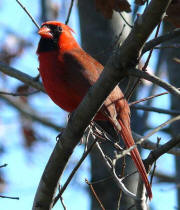 |
| Northern Cardinal |
The Cardinals are a family of passerine birds
that are robust, seed-eating birds, with strong
bills. They are typically associated with open
woodland. The sexes usually have distinct plumages.
There are 43 species world wide, 13 North American
species and eight Florida species.